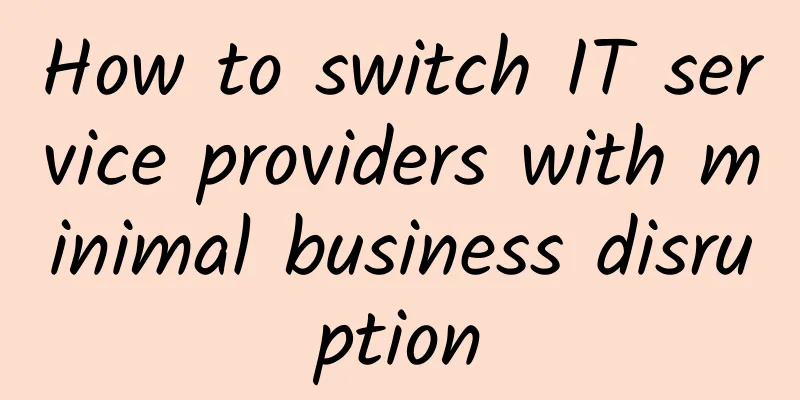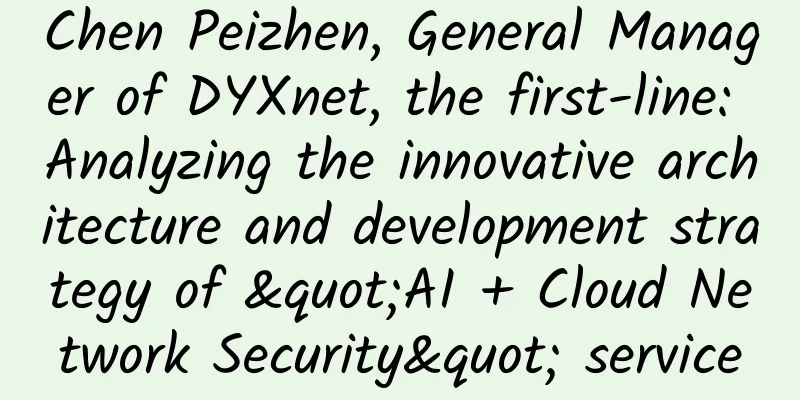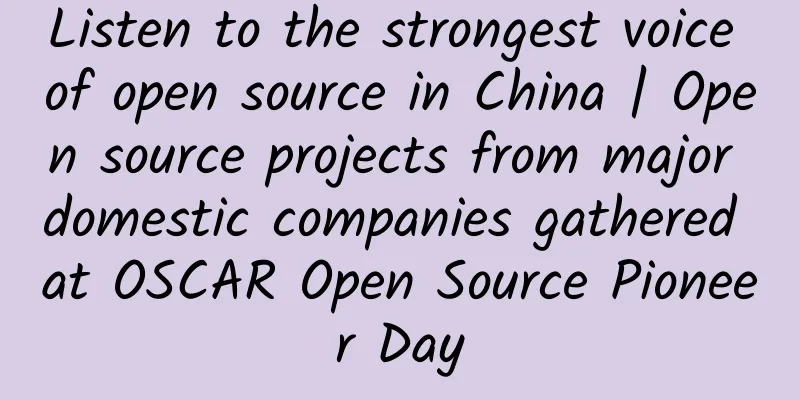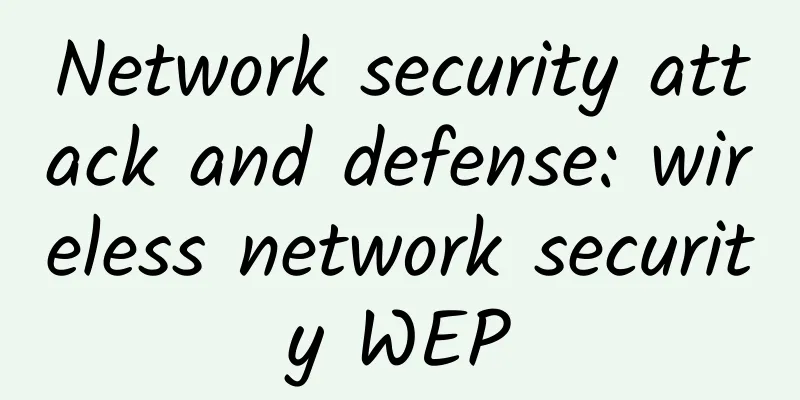How to switch IT service providers with minimal business disruption

|
At the beginning of 2020, many organizations listed IT investment as a key priority for 2020. However, a few months later, due to the coronavirus epidemic, the business of many organizations came to a standstill. While organizations must be cautious as they adapt to the “new normal,” there are risks in putting investments on hold entirely. Those that invest in changes to business operations that increase efficiency and reduce costs will be better off in the long run. Business innovation requires research and planning. Changes in business operations must be seamless and avoid disruption. first step If the IT service provider falls short in terms of price, speed or even network communications, it will ultimately affect the organization's business. This will result in budget cuts in other parts of the organization, affect employees' normal work, and organizational decision makers will end up spending a lot of time and energy to solve problems or negotiate with suppliers. Many people believe that switching IT service providers is a driver for cost-efficiency and growth. However, it is important to weigh the pros and cons to achieve the move that makes more sense for the organization. For example, if flexible working hours are a priority and your current IT service provider offers a satisfactory price, there may be another solution that provides more flexibility without having to pay more. In this case, it makes sense for you to continue with your current IT service provider’s fixed contract while also temporarily outsourcing work to a provider that offers more flexible working hours. Organizations can identify their key priorities for IT service providers and negotiate first with suppliers who meet their higher standards. Organizations can negotiate in other areas, such as cost or contract length. Organizations that fully outsource their IT workloads should value trust, reliability, and speed. As the sole IT service provider, the vendor will act as an extension of their internal team and, therefore, should be trusted like an organization's employees. Although a trusted and fast supplier may charge higher fees, it avoids the downtime and disruption costs associated with slower, less responsive suppliers. Internal and external teams Many organizations often create in-house IT teams because this often improves reliability and resolves issues faster, but for many startups and small to medium-sized organizations, these costs may not be affordable. Hiring an in-house team means paying more for salaries, training, staff benefits, etc. Given the inconsistency of IT needs, it is more economically feasible to outsource work to vendors when needed. Managing an IT environment depends on defining priorities. Organizations that prioritize speed and access, such as e-commerce organizations, may want to invest heavily in internal teams to minimize the risk of downtime that could impact customers. However, over time, an organization's needs may change. For many organizations, a combination of in-house teams and outsourced staffing provides convenience and financial stability. An organization's IT director may be tasked with building the organization's IT infrastructure and managing system performance, while unexpected problems or projects can be outsourced to an IT provider so as not to affect day-to-day work. What services do you need from the new supplier? Organizations can share their ambitions and values with IT vendors and get help delivering business growth, from cost savings to faster, more efficient, and innovative services. Rather than hiring an internal IT team, organizations can leverage the knowledge and labor of an external team of IT experts and pay only when needed. This allows small and medium-sized organizations to gain the specialized skills needed to streamline their IT systems while also completing complex and time-consuming tasks such as compliance. Compliance and security are among the ever-changing management tasks that can consume IT resources. However, professional IT vendors can easily keep up with the latest threats and compliance regulations. Seeking out an IT provider that takes these critical business responsibilities seriously can make life easier for small and midsize organizations. They can trust their IT partner to ensure they are secure and compliant, while giving employees more time to focus on their primary responsibilities. Ambitious organizations will also seek out vendors that share their forward-thinking approach. Some people mistake IT outsourcing as an easy quick fix or short-term approach. When a problem arises, the organization seeks help from a third party and ends the relationship once the problem is resolved. In fact, modern IT outsourcing is an effective way to manage the IT environment, which contributes to the long-term growth of the IT business. Nowadays, more and more IT vendors are working with organizations on expansion projects, which include building the entire IT infrastructure and developing a future roadmap. Make a switch Communication and exchange are key to a smooth switch to a new IT service provider. Both parties must agree on the terms of cooperation, including responsibilities, working hours and contact methods. Establishing shared expectations with IT service providers from the outset can better enhance collaboration. For example, setting the IT service provider's working hours outside the organization's operating hours can minimize downtime or impact on employees. Identifying account managers and key contacts means your IT service provider understands the business as well as your employees and acts as an extension of the team. This enables the organization to proceed with minimal delay or disruption. Organizations switching from an existing vendor should establish a partnership between their existing vendor and the new vendor. This allows the new vendor to keep pace with the current IT environment, unfinished work, and ongoing projects. For organizations with in-house IT departments, defining boundaries is critical. Each team needs to understand where they have ownership and autonomy. This increases efficiency and minimizes delays associated with logouts. And once a contract is signed, constant communication is required. As with any business transformation, there will be obstacles in the collaboration, so regular feedback meetings are recommended. For example, a weekly conference call with the account manager to discuss outstanding work, timelines, and to raise issues that need to be resolved. It is important for the organization to resolve issues, maintain good partnerships, and reduce the risk of business disruption. |
<<: SKT launches online-only plans for 5G and 4G customers
>>: Is 2021 really the first year of 5G toB?
Recommend
Interesting explanation of TCP three-way handshake and four-way wave
Students who have studied computer networks know ...
DiyVM: Hong Kong/Japan/US VPS discounts up to 50%, 2G memory package starting at 69 yuan per month
It's been a long time since I shared informat...
Recommended DNS public servers
114 Public DNS Universal high-speed version: DNS ...
[Double Holiday] spinservers: 1Gbps unlimited traffic server from $59/month - E3-1280v5, 32G memory, 1TB NVme, Dallas/San Jose data center
spinservers has released a promotion for the upco...
Year-end review: 2020 network communication "three major" keywords
In 2020, the COVID-19 pandemic spread wildly arou...
Veeam appoints new general manager for China, believes in the potential of availability
[51CTO.com original article] Veeam ON Forum hoste...
How do SD-WAN solutions improve network performance?
In the 2016 National WAN Report survey, responden...
Where should the JWT be stored? Did you find it?
[[428158]] I have used JWT as an authentication t...
my country's industrial Internet platform construction faces four major bottlenecks
The Guiding Opinions of the State Council on Deep...
Is LoRaWAN the solution to cellular IoT challenges?
Ten years ago, there were high hopes for cellular...
TmhHost: 20% off for Los Angeles CN2 GIA high-defense, 20% off for Hong Kong NTT data center VPS, US CN2 GIA quarterly payment starting from 70 yuan
TmhHost is a Chinese VPS service provider establi...
Can the telecommunications operating market break out of the "siege" under the epidemic's "stay-at-home economy"?
In 2020, the "new crown" black swan cam...
Operators' 2G/3G network withdrawal may accelerate
As 4G coverage deepens and 5G commercial scope co...
A simple guide to Wi-Fi, a must-read when buying a router
In this article, we will talk about the wireless ...
Global users' views on 5G: Five keys to commercial success
Recently, Ericsson Consumer Lab released the &quo...









